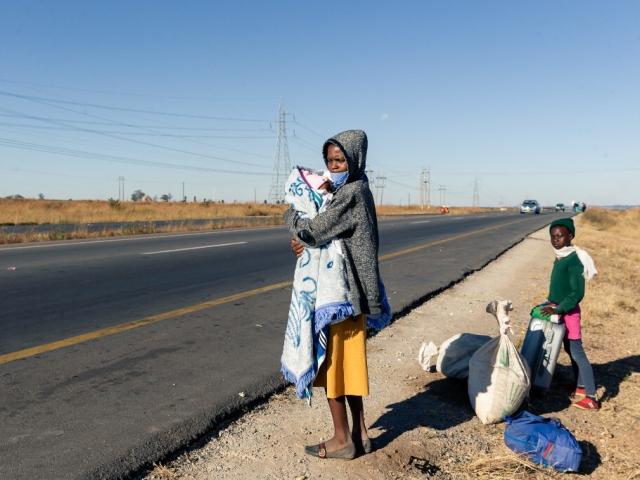-
Driver education company Zutobi told TV channel eNCA that its recent study had found South Africa – with a safety score of just 3.41 out of 10 – to be the world’s most dangerous country to drive in.
-
But the report only covers 53 out of 197 countries, only includes three African countries, and is skewed towards wealthier countries where road traffic deaths tend to be fewer.
-
It also doesn’t look at road infrastructure. An expert said when all factors were taken into account, South Africa’s road safety was “somewhere in the middle”.
Buckle up, South African TV channel eNCA told viewers in May 2022 as it reported a troubling statistic.
“South Africa is the most dangerous country to drive in,” the news anchor said, looking slightly unnerved. She attributed this claim to a study by Zutobi, an international driver’s education company.
According to the study, South Africa had a safety score of 3.41 out of 10, with alcohol and low seatbelt use contributing factors.
Zutobi co-founder Leo Waldenback did not hold back, telling eNCA that South Africa’s figures were “staggering”, frustrating and “too damn high”.
“Your roads really are dangerous when looking at the data and I think you have to have massive awareness campaigns, stricter education [and] stricter laws,” he said. Other news outlets also reported the claim.
Serious motor vehicle accidents often make headlines in South Africa. In 2020, there were 848 road traffic deaths in the country, according to the transport ministry. In 2021, this figure declined marginally to 822.
But does recent data show that South Africa is the most dangerous country in the world to drive in? We checked.
Data from the WHO and Wikipedia
Zutobi operates in the US, UK, Australia, Sweden, Germany and France. It provides learner drivers with materials to help them pass their driver’s test.
Every year, the company releases a report titled The World’s Safest Roads. The latest ranked 53 countries based on the following factors:
- Estimated road traffic death rate per 100,000
- Maximum motorway speed limit
- Seat-belt wearing rate
- Road traffic deaths attributed to alcohol
- Blood-alcohol concentration (BAC) limit for drivers
An overall safety driving score out of 10 was then calculated.
According to Zutobi’s 2022 report, South Africa ranked at the bottom of the list. This was based primarily on its low seat-belt wearing rate – just 31% of people in front seats wore seatbelts. The country was also reported to have a high rate of road traffic deaths attributed to alcohol, at 57.5%.
Norway was ranked the safest country in the world to drive in with a seat-belt wearing rate of 95.2%. Just 13% of road traffic deaths there were attributed to alcohol, contributing to an overall score of 8.20 out of 10.
Where did the report get its data?
In its methodology section, Zutobi says the data for estimated road traffic deaths, seat-belt wearing rates, road traffic deaths attributed to alcohol, and BAC limits came from the World Health Organization’s Global Health Observatory database.
The data for maximum motorway speed limits came from Wikipedia, a free online encyclopaedia. But its entries can be written and edited by anyone, so it is generally not considered a reliable source of information.
Countries chosen based on data availability
Countries were included based on the availability of data, Leila Jones, a member of the team that compiled the report, told Africa Check.
“The original countries were chosen as those were the ones we could get full data for in every factor,” she said. Each country was given a “relative score” out of 10 in each category.
“For example, the country with the lowest rate of estimated road traffic fatalities scored 10 and the country with the highest rate would score 0 in this factor,” Jones said.
“To get the country score out of 10, we took the average score of each country across all factors.”
But a look at the WHO data shows that most of it is not recent.
Binta Sako is the technical officer for tobacco and other noncommunicable death risk factors at the WHO Africa regional office. She told Africa Check that the data on road traffic deaths was collected in 2016 for a report released in 2018.
Reported death rates versus WHO estimates
Sako said the organisation could not compile data yearly as it “is a very tedious task”. The WHO is currently compiling data for its next report, due in 2023.
“Countries have their own monitoring and reporting of traffic deaths and we know this to be inadequate in many countries as the data comes from various sources and does not always capture the full numbers of road fatalities,” Sako said.
She added that the WHO used statistical methods to estimate deaths based on many variables. As a result, the estimated numbers tend to be much higher than the reported numbers.
The WHO Global Health Observatory has road traffic death estimates for years up to 2019. But the most recent data that includes reported figures from countries was from 2016, she said.
Other indicators such as seat-belt wearing, alcohol-attributed road traffic deaths and BAC limits have estimates for years up to 2017.
Other countries have worse rates in key categories
The 2016 data shows that African countries had the highest road traffic death rates, at an average 26.6 deaths per 100,000 people. Europe had the lowest, with 9.3 deaths per 100,000.
South Africa’s estimated road traffic death rate was 25.8 per 100,000 people, higher than the global average of 18.2 per 100,000 people but lower than the continent’s average.
“South Africa has one of the highest rates according to our last estimations. However some countries in Africa have higher fatality rates than South Africa,” Sako said.
The WHO does not have statistics of alcohol-attributed road traffic deaths for every country, particularly many African countries. South Africa’s rate, as the Zutobi report points out, was one of the highest globally at 57.5% in 2017. In comparison, Uganda’s was 0.8%, Nigeria’s 0.5% and Ethiopia’s 4.3%.
But South Africa did not have the lowest scores in all key categories. For wearing seat belts, Bolivia (3.5%), India (7.3%), Peru 15.8% and Ecuador (26%) reported rates lower than South Africa’s 31%. And Thailand reported higher rates of road traffic deaths at 32.2 per 100,000 people.
South Africa’s road safety ‘somewhere in the middle’ – experts
Dr Lee Randall is a postdoctoral research consultant for the South African Medical Research Council Wits Centre for Health Economics and Decision Science (or Priceless SA).
In an article for the media and academic oriented online outlet the Conversation, Randall calls Zutobi’s 2021 report misleading, saying there are significant issues with the methods of research.
For example, the report only covers 53 out of 197 countries, and South Africa, Mauritius and Morocco are the only African countries included.
“The survey is strongly biased towards high-income countries, which make up 63% of the list,” she writes. She adds that no low income countries appear at all.
The 2018 WHO report found that the rate of road traffic deaths “generally decreases as income increases.”
Randall adds that the Zutobi report largely concentrates on drivers’ behaviour and, other than looking at motorway speed limits, does not consider other factors such as road infrastructure, “a key road safety metric”.
The report therefore creates the false impression that South Africa is the worst in the world in terms of road safety when it is actually “somewhere in the middle”, she argues.
“Compared with many other African countries, South Africa has at least the beginnings of an institutional framework for road safety, with a lead agency, the Road Traffic Management Corporation, which is missing in many other countries. It also has some degree of government funding for road safety interventions,” she writes.
Randall told Africa Check that her comments on Zutobi’s 2021 report also applied to the 2022 report. The Road Traffic Management Corporation released statistics inconsistently, she said, making it difficult to measure the country’s progress. But the data that has been released shows South Africa has made “limited progress” in improving road safety.
“The figures I’ve seen imply that we've managed to save the equivalent of about 100 lives per year since 2015, representing a decrease of less than 1% per annum and very far short of the 4% per annum target set in our own National Road Safety Strategy 2016-2030,” she said.
Conclusion: Limited report with uneven methodology doesn’t support claim that South Africa is world’s most dangerous country for drivers
US-based drivers’ education company Zutobi recently claimed that South Africa was the most dangerous country in the world to drive in.
Zutobi’s 2022 study based its findings largely on data from the WHO. But the health agency’s data was in turn compiled in 2016. And the study only looked at 53 countries, only three of them African.
According to WHO data, South Africa has recorded higher than average road traffic death rates, relatively low rates of seat-belt wearing, and one of the world’s highest percentages of road traffic deaths attributed to alcohol.
But experts warn that monitoring and reporting can be “inadequate” in many countries. The Zutobi report is also biased towards high-income countries – low-income countries generally report higher rates of road traffic deaths.
An expert told us that when data from low-income countries and other safety factors were taken into account, South Africa’s road traffic safety was “somewhere in the middle”.
We therefore rate the claim as incorrect.





Add new comment